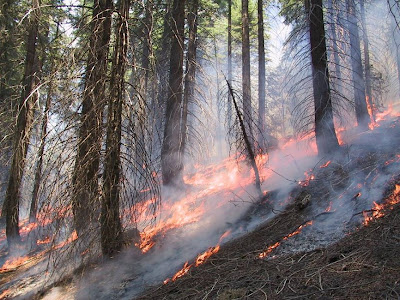
* The 2003 Okanagan Mountain Park Fire was started by a lightning strike near Rattlesnake Island in Okanagan Mountain Park in British Columbia, Canada, during one of the driest summers in the past decade. The final size of the firestorm was over 250 square kilometres (61,776 acres). 60 fire departments, 1,400 armed forces troops and 1,000 forest fire fighters took part in controlling the fire, but were largely helpless in stopping the disaster.
* The Yellowstone National Park Fire of 1988 burned well over 793,880 acres (321,271 ha) before the winter snows put out the flames. (See: Yellowstone fires of 1988)
* One of the largest known wild fires, was the Great Fire of 1910, that burned in Montana and Idaho.

* The Zaca Fire burned Los Padres NF, CA. It burned 240,207 acres. It is the 2nd largest recorded fire in California.
* Siege of 1987 Refers to a complex of fires in northern California and southern Oregon that burned a total of about 650,000 acres. These fires were started by a large lightning storm in late August. The storm started roughly 1600 new fires, most caused by dry lightning. Firefighting efforts continued into October, before the majority of the fires were controlled.
* McNally Fire Sequoia NF burned roughly 151,000 acres in 2002, and is the largest wildfire recorded in the forest's history.

* The 2003 Canberra bushfires infringed on the Australian capital itself. A firestorm raced through Canberra suburbs on January 18, 2003 and damaged or destroyed 431 homes.
* In 2004, approximately 6.5 million acres burned in Alaska, in the state's largest recorded fire season. Over 500,000 acres burned in the Boundary Fire north of Fairbanks.

* The 2007 Greek fires were some of the deadliest in world history, killing at least 64 people in Peloponnese and Evia.
* The 2007 Southern California wildfires, burning an estimated 500,000 acres of land (in the San Diego and Malibu areas), with almost 900,000 people evacuated from the area.
(source: wikipedia)

